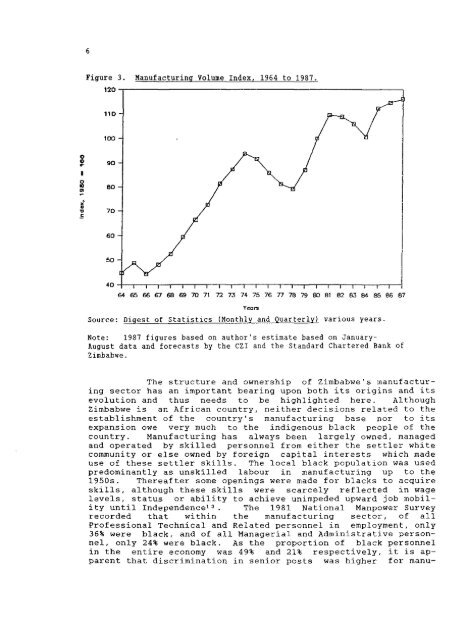Zimbabwe - Overseas Development Institute
Zimbabwe - Overseas Development Institute
Zimbabwe - Overseas Development Institute
You also want an ePaper? Increase the reach of your titles
YUMPU automatically turns print PDFs into web optimized ePapers that Google loves.
Figure 3. Manufacturing Volume Index, 1964 to 1987.<br />
120 •<br />
I<br />
I<br />
s<br />
- 1 — I — I — I — I — I — I — 1 — I — 1 — r — I — I — 1 — I — r<br />
64 65 66 67 68 69 70 71 72 73 74 75 76 77 7 S 7 9 8 D 8 1 62 83 84 85 86 87<br />
Source: Digest of Statistics (Monthly and Quarterly) various years.<br />
Note: 1987 figures based on author's estimate based on January-<br />
August data and forecasts by the CZI and the Standard Chartered Bank of<br />
<strong>Zimbabwe</strong>.<br />
The s t r u c t u r e and ownership of <strong>Zimbabwe</strong>'s manufacturing<br />
sector has an important bearing upon both i t s o r i g i n s and i t s<br />
e v o l u t i o n and thus needs to be h i g h l i g h t e d here. Although<br />
<strong>Zimbabwe</strong> i s an A f r i c a n country, neither d e c i s i o n s r e l a t e d to the<br />
establishment of the country's manufacturing base nor to i t s<br />
expansion owe very much to the indigenous black people of the<br />
country. Manufacturing has always been l a r g e l y owned, managed<br />
and operated by s k i l l e d personnel from e i t h e r the s e t t l e r white<br />
community or else owned by f o r e i g n c a p i t a l i n t e r e s t s which made<br />
use of these s e t t l e r s k i l l s . The l o c a l black population was used<br />
predominantly as u n s k i l l e d labour i n manufacturing up to the<br />
1950s. Thereafter some openings were made f o r blacks to acquire<br />
s k i l l s , although these s k i l l s were s c a r c e l y r e f l e c t e d i n wage<br />
l e v e l s , status or a b i l i t y to achieve unimpeded upward job mobili<br />
t y u n t i l Independence'3. The 1981 National Manpower Survey<br />
recorded that w i t h i n the manufacturing sector, of a l l<br />
P r o f e s s i o n a l Technical and Related personnel i n employment, only<br />
36% were black, and of a l l Managerial and A d m i n i s t r a t i v e personn<br />
e l , only 24% were black. As the proportion of black personnel<br />
i n the e n t i r e economy was 49% and 21% r e s p e c t i v e l y , i t i s apparent<br />
that d i s c r i m i n a t i o n i n senior posts was higher f o r manu-
















